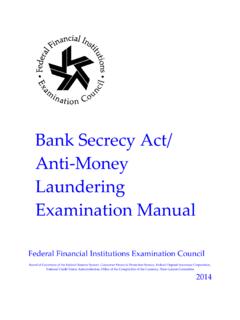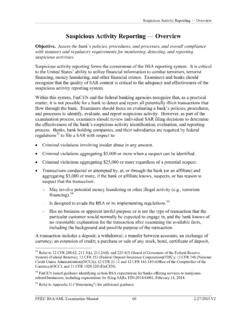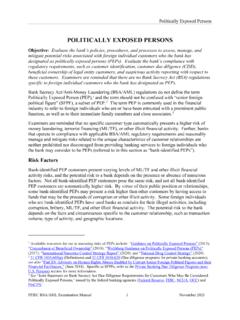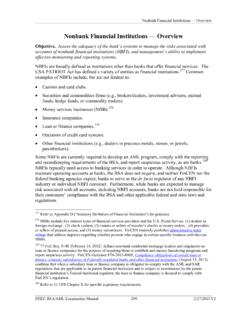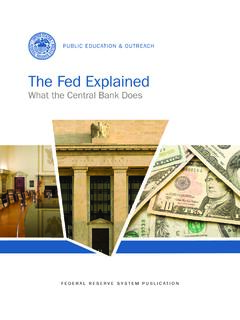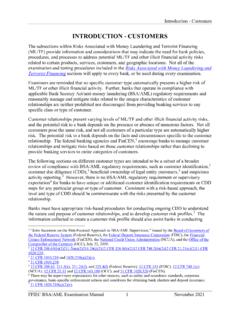Transcription of Overview - Federal Financial Institutions Examination Council
1 Funds Transfers Record Keeping Overview FFIEC BSA/AML Examination Manual 104 2/27 Funds Transfers Recordkeeping Overview Objective. Assess the bank s compliance with statutory and regulatory requirements for funds transfers. This section covers the regulatory requirements as set forth in the BSA. Refer to the expanded sections of this manual for discussions and procedures regarding specific money laundering risks for funds transfer activities. Funds transfer systems enable the instantaneous transfer of funds, including both domestic and cross-border transfers.
2 Consequently these systems can present an attractive method to disguise the source of funds derived from illegal activity. The BSA was amended by the Annunzio Wylie Anti-Money Laundering Act of 1992 to authorize the Treasury and the Federal reserve Board to prescribe regulations for domestic and international funds transfers. In 1995, the Treasury and the Board of Governors of the Federal reserve system issued a final rule on recordkeeping requirements concerning payment orders by banks (31 CFR The rule requires each bank involved in funds transfers111 to collect and retain certain information in connection with funds transfers of $3,000 or The information required to be collected and retained depends on the bank s role in the particular funds transfer (originator s bank, intermediary bank, or beneficiary s bank).)
3 113 The requirements may also vary depending on whether an originator or beneficiary is an established customer of a bank and whether a payment order is made in person or otherwise. Also in 1995, the Treasury issued a final rule that requires all Financial Institutions to include certain information in transmittal orders for funds transfers of $3,000 or more (31 CFR ).114 This requirement is commonly referred to as the Travel Rule. 110 31 CFR (a) is the recordkeeping rule for banks, and 31 CFR (e) imposes similar requirements for nonbank Financial Institutions that engage in funds transfers.
4 The procedures in this core Overview section address only the rules for banks in 31 CFR (a). 111 Funds transfer is defined under 31 CFR Funds transfers governed by the Electronic Fund Transfer Act of 1978, as well as any other funds transfers that are made through an automated clearing house, an automated teller machine, or a point-of-sale system , are excluded from this definition and exempt from the requirements of 31 CFR (a), and 31 CFR (e) and (f). 112 31 CFR (a)(6) provides exceptions to the funds transfer requirements.
5 Funds transfers where both the originator and the beneficiary are the same person and the originator s bank and the beneficiary s bank are the same bank are not subject to the recordkeeping requirements for funds transfers. Additionally, exceptions are provided from the recordkeeping requirements for funds transfers where the originator and beneficiary are: a bank; a wholly owned domestic subsidiary of a bank chartered in the United States; a broker or dealer in securities; a wholly owned domestic subsidiary of a broker or dealer in securities; the United States; a state or local government; or a Federal , state or local government agency or instrumentality.
6 113 These terms are defined under 31 CFR . 114 The rule applies to both banks and nonbanks (31 CFR (f). Because it is broader in scope, the Travel Rule uses more expansive terms, such as transmittal order instead of payment order and transmittor s Financial institution instead of originating bank. The broader terms include the bank-specific terms. Funds Transfers Record Keeping Overview FFIEC BSA/AML Examination Manual 105 2/27 Responsibilities of Originator s Banks Recordkeeping Requirements For each payment order in the amount of $3,000 or more that a bank accepts as an originator s bank, the bank must obtain and retain the following records (31 CFR (a)(1)(i): Name and address of the originator.))
7 Amount of the payment order. Date of the payment order. Any payment instructions. Identity of the beneficiary s institution. As many of the following items as are received with the payment order: Name and address of the beneficiary. Account number of the beneficiary. Any other specific identifier of the Recordkeeping Requirements for None stablished Customers If the originator is not an established customer of the bank, the originator s bank must collect and retain the information listed above. In addition, the originator s bank must collect and retain other information, depending on whether the payment order is made in person.
8 Payment Orders Made in Person If the payment order is made in person, the originator s bank must verify the identity of the person placing the payment order before it accepts the order. If it accepts the payment order, the originator s Financial institution must obtain and retain the following records: Name and address of the person placing the order. Type of identification reviewed. Number of the identification document ( , driver s license). The person s taxpayer identification number (TIN) ( , Social Security number (SSN)or employer identification number (EIN)) or, if none, the alien identification number orpassport number and country of issuance, or a notation in the record of the lack the originator s bank has knowledge that the person placing the payment order is notthe originator, the originator s bank must obtain and record the originator s TIN ( ,SSN or EIN)
9 Or, if none, the alien identification number or passport number and countryof issuance, or a notation of the lack Transfers Record Keeping Overview FFIEC BSA/AML Examination Manual 106 2/27 Payment Orders Not Made in Person If a payment order is not made in person, the originator s bank must obtain and retain the following records: Name and address of the person placing the payment order. The person s TIN ( , SSN or EIN) or, if none, the alien identification number orpassport number and country of issuance, or a notation in the record of the lack thereof,and a copy or record of the method of payment ( , check or credit card transaction) forthe funds transfer.
10 If the originator s bank has knowledge that the person placing thepayment order is not the originator, the originator s bank must obtain and record theoriginator s TIN ( , SSN or EIN) or, if none, the alien identification number orpassport number and country of issuance, or a notation of the lack Information retained must be retrievable by reference to the name of the originator. When the originator is an established customer of the bank and has an account used for funds transfers, information retained must also be retrievable by account number (31 CFR (a)(4).)
